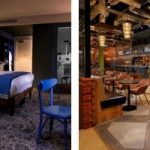Throughout the COVID-19 pandemic, the senior living industry has had to make some of the most drastic changes. While they have most of the same health risks as hotels and restaurants, shutting down is just not an option for them. While senior living communities have taken the challenge in stride, it has been incredibly stressful for both residents and employees. Now, facilities are looking at how they can design their spaces to make preventing, and responding to, future potential outbreaks less of a challenge.
Flexible Lobbies
Of all the areas of a senior living facility, lobbies are the most exposed to outside infection. They also are often a major thoroughfare within a facility, creating a hotbed of infection points. Existing facilities can designate contained areas, either inside or preferably outside, for deliveries and visitors to wait. For new facilities, lobbies can be built to incorporate physically separated areas where visitors can be given rapid results tests and deliveries can be disinfected.
A Focus on Stairs
In multi-level residencies, the elevator areas can be problematic for social distancing. Not only does riding a crowded elevator and touching buttons carry a risk of infection, but residents are also at risk when they stand in groups waiting to get in. Encouraging the more mobile seniors to use the stairs will reduce the congestion that often surrounds elevators. For existing facilities with only emergency stairwells, this could mean adding extra lighting, updated flooring, background music, and keeping doors open to make the extra effort more enticing. New facilities will want to make sure there are plenty of prominently featured, spacious, and attractive stairways to keep elevator traffic to a minimum.
Communal Spaces Redesigned
Most residents are drawn to the social opportunities that senior living facilities offer, but large gatherings may not be feasible for some time. Creating multiple communal spaces throughout facilities can allow residents to have in-person social interactions near their room, without the risks that come from walking across the entire facility to spaces used by everyone.
More Access to Fresh Air
Taking advantage of outdoor access will be a huge focus for all senior living facilities. Even if a facility already has ample outdoor space, it will need to have multiple access points to reduce congestion around a few main exits. Having access from rooms would be ideal when possible. Facilities can also consider creating physically defined areas designed for exercise, dining, lounging, and even some programming like art classes or educational workshops. Many residents would happily adjust to many activities moving to outdoor spaces if they are comfortable and properly equipped.
Invest in Workers
Giving employees separate designated spaces to store and change into PPE, perform administrative tasks, and take breaks comfortably can help prevent burnout and keep teams resilient. Communities will also be looking at changing existing roles, as well as adding new ones, to anticipate the changing needs of seniors.
Having the right management in place is essential for facilities to be able to prevent and deal with crises. The senior living recruitment experts at Horizon Hospitality will help you find the leaders with the expertise and flexibility to guide your team. Contact them today to learn more.
The post How Will COVID-19 Impact Existing and Future Senior Living Design? appeared first on Horizon Hospitality.































